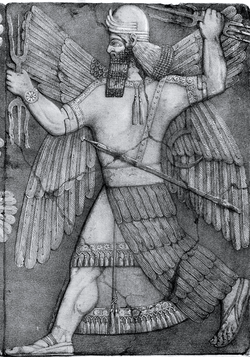Ninurta facts for kids
Quick facts for kids Ninurta𒀭𒊩𒌆𒅁 |
|
|---|---|
| God of agriculture, hunting, and war | |

Assyrian stone relief from the temple of Ninurta at Kalhu, showing the god with his thunderbolts pursuing Anzû, who has stolen the Tablet of Destinies from Enlil's sanctuary (Austen Henry Layard Monuments of Nineveh, 2nd Series, 1853)
|
|
| Abode | Eshumesha temple in Nippur Later Kalhu, during Assyrian times |
| Planet | Saturn |
| Symbol | Plow and perched bird |
| Mount | Sometimes shown riding a beast with the body of a lion and the tail of a scorpion |
| Consort | As Ninurta: Gula As Ninĝirsu: Bau |
| Parents | Usually Enlil and Ninhursag, but sometimes Enlil and Ninlil |
Ninurta, also known as Ninĝirsu (meaning “Lord of Girsu”), was an important ancient Mesopotamian god. People in early Sumer first worshipped him. He was linked to many things like farming, healing, hunting, laws, writing, and war.
At first, Ninurta was known as a god of farming and healing. People believed he could free them from sickness and evil spirits. Later, as the lands of Mesopotamia became more focused on war, Ninurta also became a powerful warrior god. But he still kept his connections to farming. He was seen as the son of the main god, Enlil. His most important place of worship in Sumer was the Eshumesha temple in Nippur.
Contents
Ninurta's Worship and Temples
King Gudea of Lagash (who ruled from 2144–2124 BC) greatly respected Ninĝirsu. King Gudea even rebuilt Ninĝirsu's temple in Lagash.
How Assyrians Honored Ninurta
Later, the Assyrians loved Ninurta because he was a strong warrior. The Assyrian king Ashurnasirpal II (who ruled from 883–859 BC) built a huge temple for Ninurta in a city called Kalhu. This temple became the most important place to worship Ninurta from then on.
Why Ninurta's Temples Were Destroyed
After the Assyrian Empire fell, people tore down Ninurta's statues and left his temples empty. This happened because Ninurta had become too closely linked to the Assyrian rulers. Many people who had been conquered by the Assyrians saw their rule as unfair and harsh.
Stories and Myths About Ninurta
Ninurta appears in several ancient stories and myths.
Ninurta's Fight Against Asag
In a long poem called Lugal-e, Ninurta defeats a monster named Asag. He uses his special talking mace, a weapon called Sharur. After this, he uses stones to create the Tigris and Euphrates rivers. This made the rivers useful for watering crops.
Ninurta's Farming Advice
There is also a poem sometimes called the "Sumerian Georgica". In this poem, Ninurta gives helpful advice to farmers about how to grow their crops.
Ninurta and the Anzû Bird
In another myth from the Akkadian people, Ninurta was the hero of the gods. He fought against the Anzû bird after it stole the Tablet of Destinies from his father Enlil. This tablet was very powerful.
Ninurta's Symbols
Ninurta's main symbols were a bird sitting on something and a plow, which is a tool used for farming.
Ninurta's Possible Connections to Other Figures
Some people believe Ninurta might have inspired other famous figures.
Ninurta and Nimrod
Ninurta might have been the idea behind Nimrod, a "mighty hunter" mentioned in the Book of Genesis in the Bible. Nimrod is also linked to the city of Kalhu. It's also possible that the stories of Ninurta were inspired by a real person, like the biblical Nimrod.
Ninurta and Nisroch
Ninurta might also be mentioned in the Second Book of Kings under the name Nisroch. In the 1800s, stone carvings from Ninurta's temple in Kalhu showed winged figures with eagle heads. People often called these figures "Nisrochs," and they appeared in fantasy books from that time.
Related pages
Images for kids
-
The Gudea cylinders, dating to c. 2125 BC, describe how King Gudea of Lagash rebuilt the temple of Ninĝirsu in Lagash as the result of a dream in which he was instructed to do so
-
1853 restoration of what the city of Kalhu, Ninurta's main cult center in the Assyrian Empire, might have originally looked like, based on the excavations of the British archaeologist Austen Henry Layard there in the 1840s
-
Limestone bust of a goddess from Girsu, possibly Ninurta's consort Bau, wearing a horned cap
-
Ninurta with his thunderbolts pursues Anzû, who has stolen the Tablet of Destinies from Enlil's sanctuary (Austen Henry Layard Monuments of Nineveh, 2nd Series, 1853)
-
Sumerian cylinder seal impression dating to c. 3200 BC showing an ensi and his acolyte feeding a sacred herd; Ninurta was an agricultural deity and, in a poem known as the "Sumerian Georgica", he offers detailed advice on farming
-
Nimrod (1832) by David Scott. Nimrod, the "great hunter" mentioned in Genesis 10:8–12, is believed by many scholars to be inspired by either Ninurta himself or the Assyrian king Tukulti-Ninurta I, named after him
See also
 In Spanish: Ninurta para niños
In Spanish: Ninurta para niños










